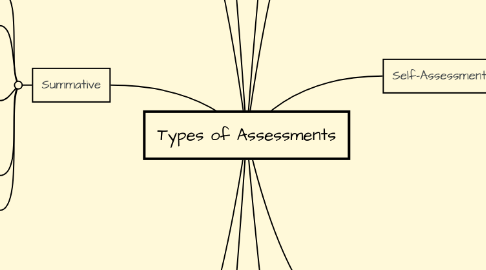
1. Diagnostic
1.1. Definition
1.2. Purpose
1.3. Advantages and Disadvantages
1.3.1. Advantages
1.3.1.1. 1) Gives teachers a jumping off point.
1.3.1.2. 2) Helps teachers differentiate based on prior student knowledge.
1.3.2. Disadvantages
1.3.2.1. 1) Diagnostics may make students feel disheartened if they cannot answer the questions.
1.4. Assessment FOR Learning
1.5. Example
1.5.1. 1. ache 2. advise 3. afford 4. astonish 5. boast 6. cheat a _____ have enough money b _____ break the rules c ____ surprise
2. Formative
2.1. Definition
2.2. Purpose
2.3. Advantages and Disadvantages
2.3.1. Advantages
2.3.1.1. 1) Allows students to receive more immediate feedback on their learning.
2.3.1.2. 2) Catches students who may be falling behind earlier in the process than other forms of assessment that wait until the end of a lesson/unit.
2.3.1.3. 3) Allows the teacher to make adjustments based on students' needs.
2.3.1.4. 4) Can be done quickly and with little interruption.
2.3.2. Disadvantages
2.3.2.1. 1) May add more grading in addition to larger asessments.
2.4. Assessment FOR Learning
2.5. Example
3. Summative
3.1. Definition
3.2. Purpose
3.3. Advantages and Disadvantages
3.3.1. Advantages
3.3.1.1. 1) Allows teachers to see if students have mastered the topic.
3.3.1.2. 2) Serves as a signifier of an end of a unit/topic.
3.3.2. Disadvantages
3.3.2.1. 1) May be anxiety-provoking for some students, and thus may not be an accurate representation of learning.
3.4. Assessment OF Learning
3.5. Example
4. Performance Based
4.1. Definition
4.2. Purpose
4.3. Advantages and Disadvantages
4.3.1. Advantages
4.3.1.1. 1) Assessment through application, allowing for a more realistic "testing" scenario than more traditional assessments.
4.3.1.2. 2) May help reduce testing anxiety because of the non-traditional nature of the assessment.
4.3.2. Disadvantages
4.3.2.1. 1) May be less black and white than other more traditional assessments.
4.3.2.2. 2) May take more time/resources, depending on the assessment.
4.3.3. Advantages
4.3.3.1. 1) More applicable to the real world than more traditional testing approaches.
4.3.3.2. 2) For students who experience testing anxiety, performance based assessments allow teachers to assess students in a way that is less anxiety-provoking.
4.3.4. Disadvantages
4.3.4.1. 1) Not all topics lend themselves to this type of assessment.
4.3.4.2. 2) This type of assessment is often less black and white than more traditional assessments.
4.4. Assessment OF Learning
4.5. Example
5. High Stakes
5.1. Definition
5.2. Purpose
5.3. Advantages and Disadvantages
5.3.1. Advantages
5.3.1.1. 1) Allows for more direct comparison of schools than may otherwise be possible.
5.3.1.2. 2) Equal tests are given to students.
5.3.2. Disadvantages
5.3.2.1. 1) Equality is not the same as equity.
5.3.2.2. 2) Students are pressured to perform well on high-stakes tests, which may cause anxiety.
5.3.2.3. 3) These tests measure against a standard score, not against students previous scores (i.e. they do not measure growth).
5.4. Assessment OF Learning
5.5. Example
6. Portfolio
6.1. Definition
6.2. Purpose
6.3. Advantages and Disadvantages
6.3.1. Advantages
6.3.1.1. 1) Promotes metacognition through self-reflection.
6.3.1.2. 2) Allows teachers to see progress based on actual student examples.
6.3.2. Disadvantages
6.3.2.1. 1) Can be difficult and time consuming to implement and manage.
6.3.2.2. 2) More subjective than more traditional forms of assessment.
6.4. Assessment OF Learning and FOR Learning
6.5. Example
7. Authentic
7.1. Definition
7.2. Purpose
7.3. Advantages and Disadvantages
7.3.1. Advantages
7.3.1.1. 1) Accurately reflects students' knowledge and skills.
7.3.1.2. 2) Lends itself to differentiation.
7.3.2. Disadvantages
7.3.2.1. 1) Not standardized, which makes it more difficult to compare scores.
7.3.2.2. 2) Often more subjective than more traditional assessments.
7.4. Assessment OF Learning and FOR Learning
7.5. Example
8. Self-Assessment
8.1. Definition
8.2. Purpose
8.3. Advantages and Disadvantages
8.3.1. Advantages
8.3.1.1. 1) Allows students to reflect on learning.
8.3.1.2. 2) Gives students the skills to accurately assess their work.
8.3.2. Disadvantages
8.3.2.1. 1) Students may not always accurately assess their own work.
8.3.2.2. 2) SUBJECTIVE. May not work well for more objective subjects.
8.4. Assessment OF Learning.
8.5. Example
9. Peer Assessment
9.1. Definition
9.2. Purpose
9.3. Advantages and Disadvantages
9.3.1. Advantages
9.3.1.1. 1) Allows both the grader and the gradee to learn in different ways than other assessments allow.
9.3.1.2. 2) Lessens the grading burden on the teacher.
9.3.2. Disadvantages
9.3.2.1. 1) Students may have trouble being objective.
